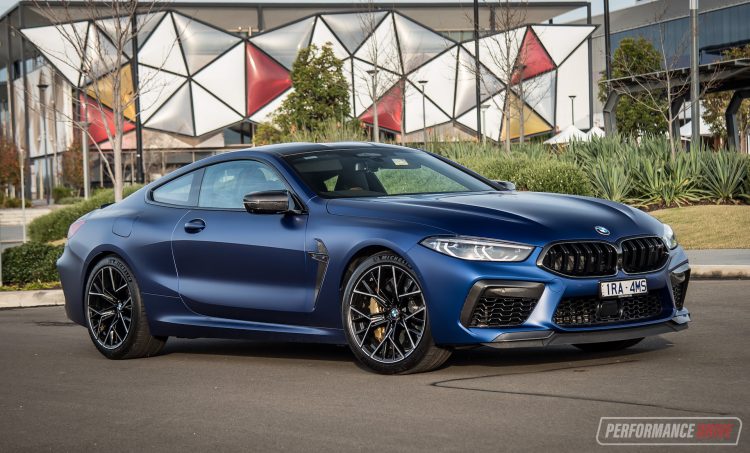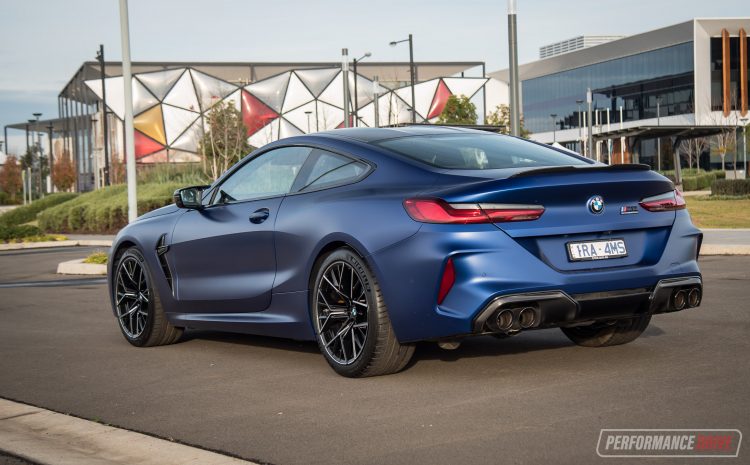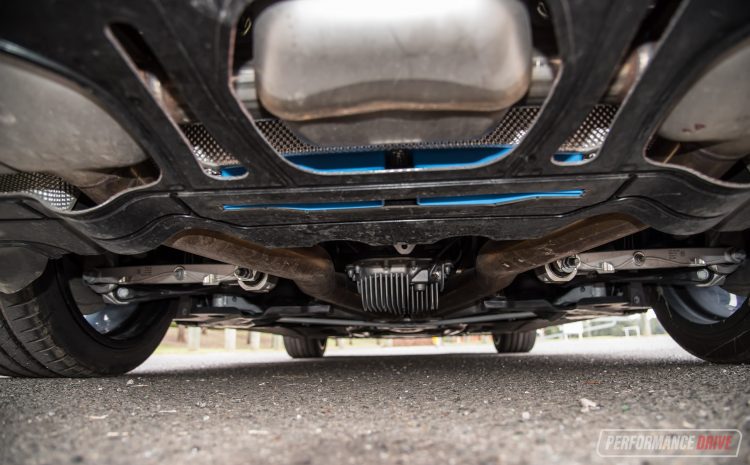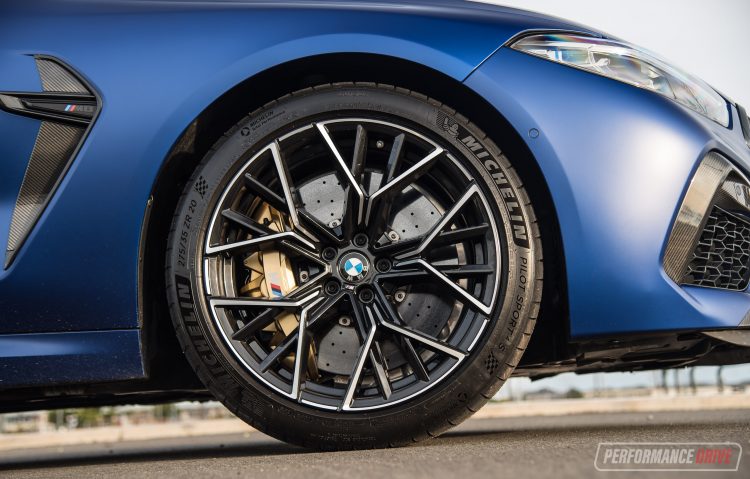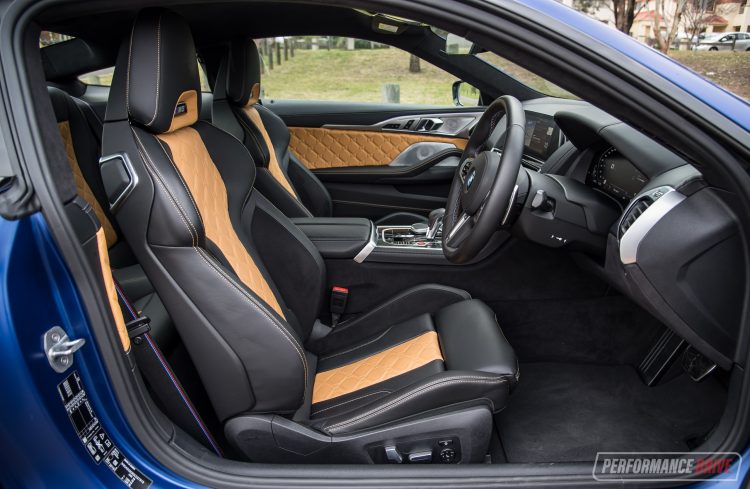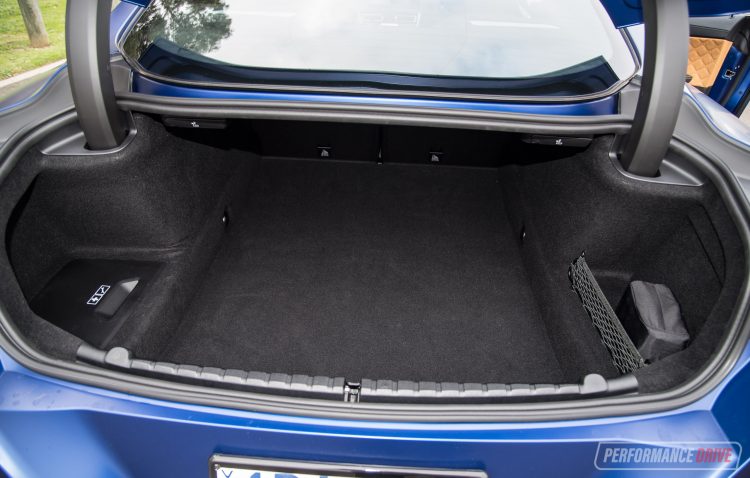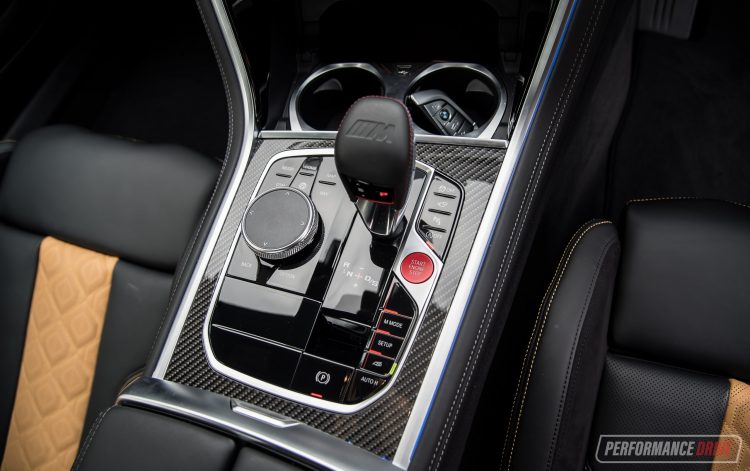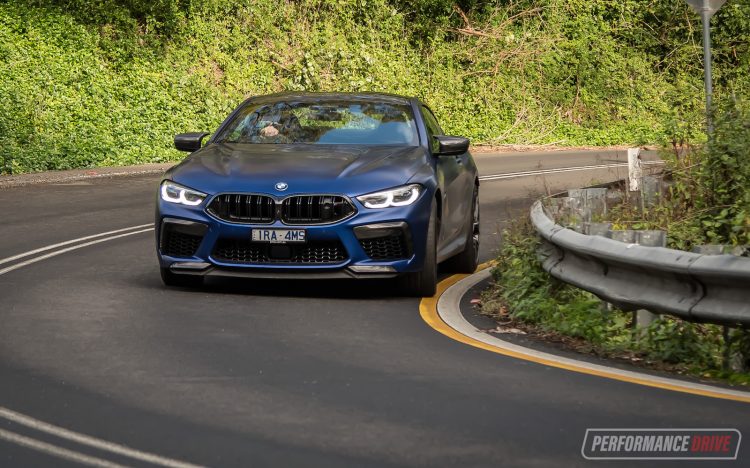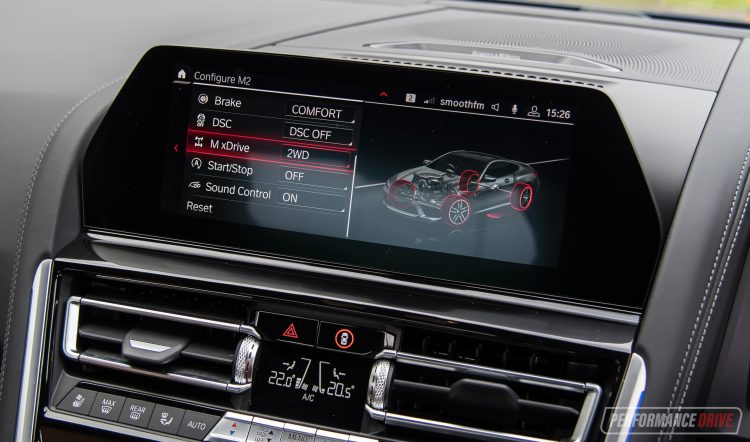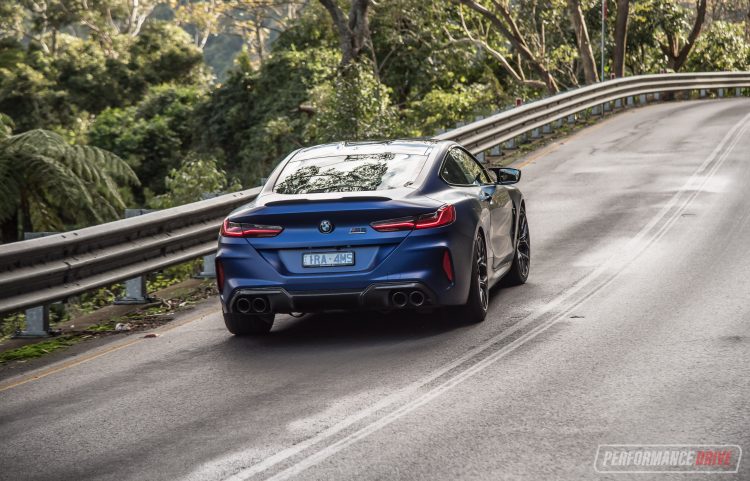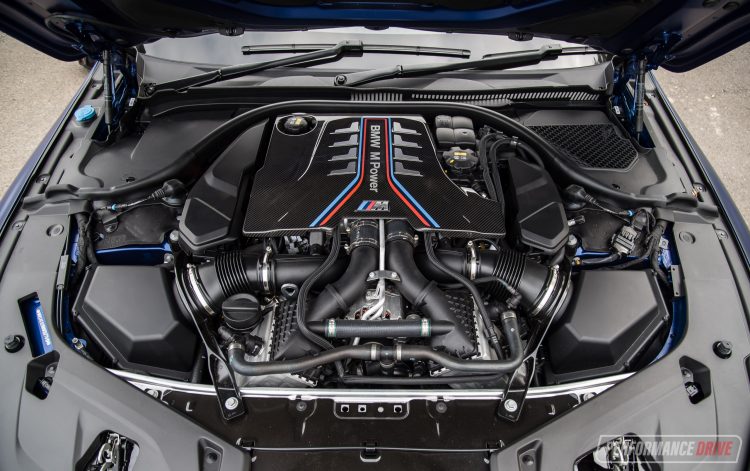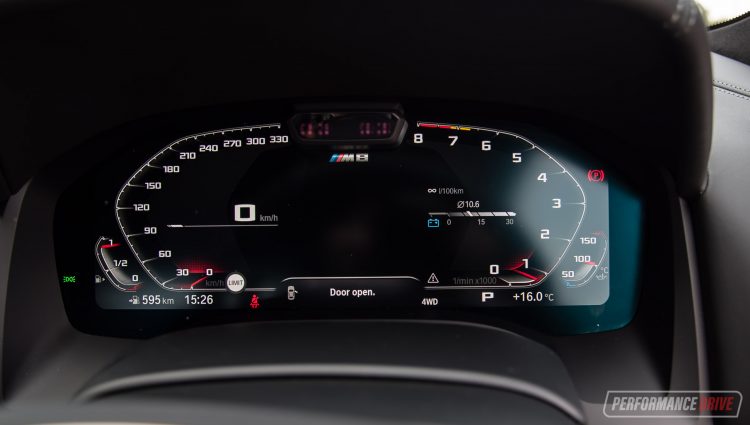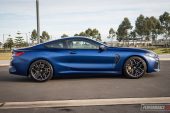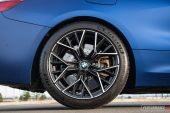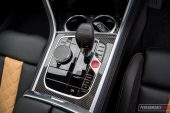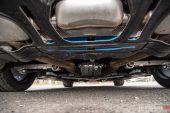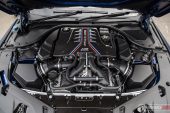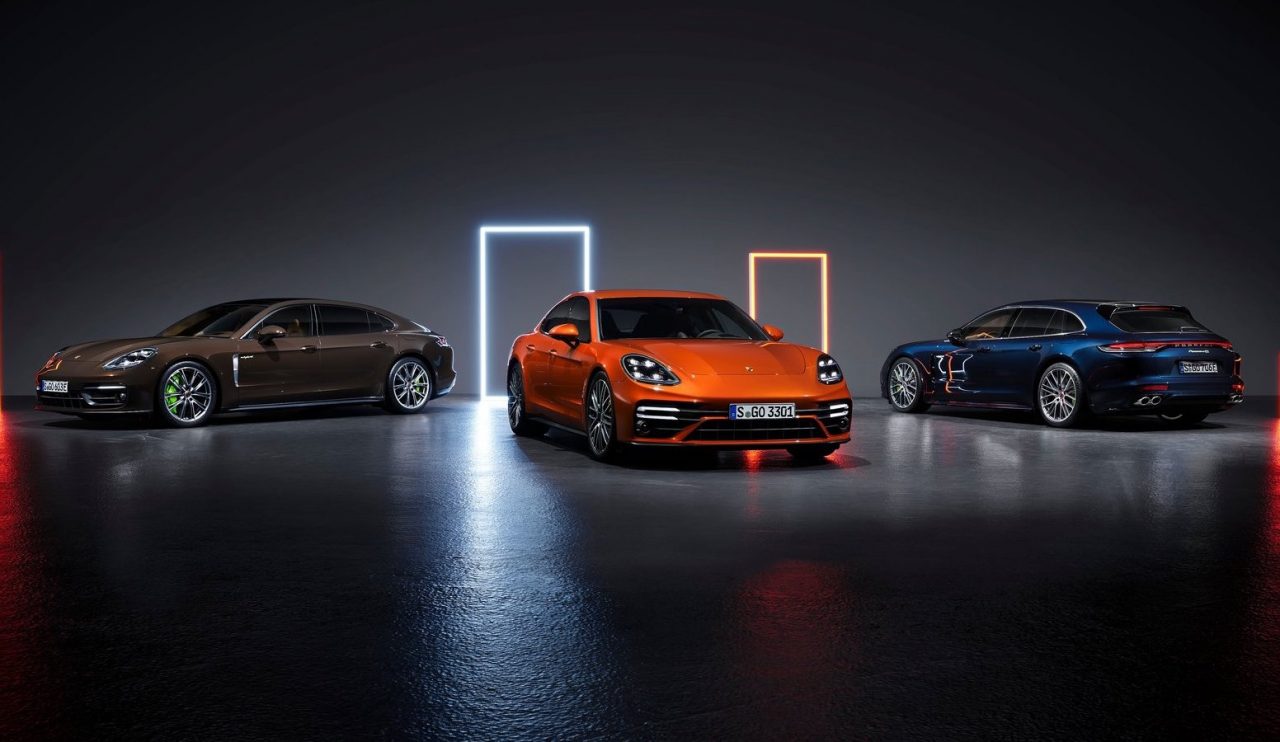Say hello to the mack daddy of all BMW M cars (except maybe the classic M1 of the 1970s). The 2020 BMW M8 Competition sits not only at the top of BMW’s sports car range, it’s also the most expensive and most powerful vehicle BMW M has ever offered.
The M8 is a motorsport-inspired extension of the new 8 Series, borrowing the same CLAR platform integrated with Carbon Core technology for lightness and rigidity. And it seems to have worked. Despite being a flagship 8 Series, which is essentially the sports car cousin to the 7 Series, this M8 Competition coupe weighs 1841kg (tare). That’s not bad at all.
In Australia only the Competition trim level is available, and buyers can choose between a traditional two-door coupe (as we have here) and the grandeur Gran Coupe four-door coupe. These share the 4.4-litre twin-turbo V8 with the M5 Competition, and X5 M Competition/X6 M Competition, producing a mega 460kW and 750Nm – the most powerful engine BMW has ever offered.
Interestingly, the coupe is more expensive than the four-door. Prices start from $357,900 for the coupe, and from $354,900 for the GC (excluding on-road costs).
2020 BMW M8 Competition – THE SPECS
[column width=”47%” padding=”6%”]Engine: 4.4-litre twin-turbo V8
Output: 460kW@6000rpm / 750Nm@1500-5600rpm
Transmission: Eight-speed auto
Drive type: All-wheel drive, switchable RWD
Wheels: F: 20×9.5, 275/35 R: 20×10.5, 285/35
ANCAP: Not tested
Tare weight: 1841kg
Power-to-weight: 4.02:1 (kg:kW)
Official fuel economy: 10.4L/100km
Economy during test: 13.2L/100km
Fuel capacity/Type: 68L/98 RON[/column] [column width=”47%” padding=”0″]Power efficiency: 44.23kW:L/100km
0-60km/h: 1.75 seconds*
0-100km/h: 3.14 seconds*
0-200km/h: 10.28 seconds*
60-110km/h: 1.86 seconds*
1/4 mile: 10.97 seconds at 206.0km/h*
Max acceleration: 1.106g
100-0km/h braking: 2.18 seconds at 36.28 metres*
Max deceleration: -1.156g
Decibel at idle (/Sport mode): 56/58*
Peak decibel at 60-100km/h: 89/92*
Priced from: $357,900[/column][end_columns]
* Figures as tested by PerformanceDrive on the day. Factory claims may be different
2020 BMW M8 Competition – THE PACKAGE
Underpinning the M8 is the CLAR platform as mentioned, with carbon fibre used for the pillars and roof as part of the ‘Carbon Core’ philosophy. However, M division has extended on that by fitting its own, stiffer engine mounts (the mount spring rate is up from 580N/mm to 900N/mm). There’s also forged link arms underneath for the double wishbone front and five-link rear suspension, and a steel X-brace at the front, and aluminium transverse strut to really tie down the rear end.
You only need to take a peek under the car to see the attention to detail, all in the effort of speed and aerodynamic optimisation. There’s special vents, and flat panelling to conceal mechanical obstacles from airflow, and a finned diffuser at the back. The rear differential also features long heat-dissipating fins, and the front end has special ducts to feed cool air to the brakes. There’s no doubt about it, this is a proper M car ready for the track.
With the Competition pack, the body is subtly decorated in black trimmings, such as front grilles, side mirrors, window surrounds, and badges. Carbon fibre is also used for certain aspects, such as the front intake surrounds, side gills, and rear lip spoiler for bonus exotica and appeal.
Overall, the M8 coupe is quite a large car and it can look a bit odd from some angles in our opinion. Some areas appear to be swollen but in unusual ways, and from the side profile it almost looks like a semi-used bar of soap. From a silhouette point of view anyway. The carbon and darkened highlights certainly add some tough and sinister attitude, as do the staggered-size 20-inch forged M wheels that wear 275/35 front and 285/35 Michelin Pilot 4 S tyres. This test car looks particularly appetising as well thanks to its Frozen Marina Bay Blue matt paint finish.
Inside, the passenger’s retreat is typically restrained and not too flashy, following BMW tradition. Although, this example shows off the two-tone leather and Alcantara upholstery. But if it weren’t for that, it does look pretty much the same as a regular 8 Series or even a 5 Series for that matter. BMW probably could have applied something a bit more dramatic and distinctive in this area.
The front seats are very pleasant and supportive, with a wide range of adjustment. Finding a perfect driving position is easy thanks to the adjustable steering column with full rake and reach extension available. This is a sports car in the most fundamental sense, so it shouldn’t come as a surprise that you do sit quite low in the cabin. It means you need to crouch down to get in, and get the legs working to press yourself up and out.
Rear passengers will find it rather confined in the back. There are just two seats, and although legroom can be adequate if the front passengers are willing to slide forward a bit, it’s the headroom that restricts the overall comfort the most. There are no climate vents in the back as standard, and the front seats are electric which results in some waiting time to get in.
Sports car it might be but there is definitely a big degree of grand touring capability as well. The boot measures 420L, which is not far off the new 4 Series coupe’s volume of 440L. And that’s more of an everyday car than this. Adding convenience is the fact the rear seats can be folded down, leaving a large poke-through tunnel for longer objects.
As for the dashboard and in-car entertainment, it’s not all that different from the regular BMW models. At least the upper models like the latest 5 Series and X5 and X6. There is some carbon fibre for the centre console, and the high quality leather extends well beyond just covering the seats; it also wraps sections of the console and door cards. Contrast stitching helps to create a 3D-like atmosphere and extra depth, too.
Atop the dash is BMW’s 12.3-inch touch-screen media interface. This runs the latest 7.0 operating system, and it can be completely controlled by the intuitive and handy iDrive pad on the console. It’s all very good and easy to use, while also presenting plenty of apps and functionality. There’s even the ability to check the car’s oil level from the screen. However, we think BMW could have done something extra for the M8 in this department. We’re not sure what exactly, but some buyers might not see it all as special enough for a $360k car.
We guess the saving grace is that BMW’s operating system is excellent, and BMW has a tendency to keep things traditional, even if it means sharing some elements with lesser models. Plenty of features are packed in as standard. A marvellous 16-speaker sound system with digital radio, sat-nav, along with head-up display, and a fully digital instrument cluster are all included.
2020 BMW M8 Competition – THE DRIVE
Let’s firstly start with its capacity as a luxury touring coupe. Yes, the suspension is quite firm. This is still an M car underneath and has been designed for track use. We wouldn’t describe it as bone-jarringly stiff, though. There is a certain suppleness over longer-pitch undulations, such as dips and gradual humps. Road reflectors and bridge connects are probably the Achilles tendon. Such occasions can be heard just as much as they can be felt.
The steering is really fluid and provides lots of feel, comprising BMW’s M Servotronic technology. It’s an electromechanical system that combines speed-sensitive assistance along with a variable steering ratio. Essentially, the weight of the steering is light and few turns are required to go from lock to lock in a car park. Meanwhile, during open road driving the weight firms up a bit (even more so in Sport mode) and the variable gearing means it isn’t touchy.
BMW offers a plethora of driving modes with the M8. Yes, it can be overwhelming at first. But if you’re a bit of a tech geek or a car nerd, the seemingly endless configurations and settings will have you transfixed for hours. Basically, there are three main driving modes that alter the steering, suspension and throttle sharpness. Then there are a few settings for the transmission and how quickly you want it to shift, and there’s also an M-first braking setting to play around with.
All modes can be adjusted and mixed and matched, and then you can store your two favourite settings and use the M1 and M2 preset buttons on the steering wheel, for quick activation. You can even switch the traction/stability control off and save it into the presets. Each time you start the car, the vehicle does go back to its default and normal settings.
There is one mode that is especially intriguing. You see, the M8 does feature xDrive all-wheel drive. The system has been tweaked by BMW M, however, BMW has creatively incorporated a unique ‘4WD Sport’ mode too, as well as a rear-wheel drive mode. Yep, you can switch it to RWD. And this can be programmed into one of those preset buttons on the steering wheel. That, is very cool.
In the 4WD Sport setting you can feel the car moving around a bit in the corners. It allows some slip, and the rear-biased power/torque delivery from the engine makes it feel nimbler and playful. The handling is rock-solid, but in this mode you can experience some light oversteer for added thrills. In BMW’s words, regarding the 4WD Sport setting:
“Here, the system diverts a larger slice of engine power to the rear wheels, opening the door to the type of effortlessly controlled drifts that feed on the linear build-up of lateral force for which M models are renowned.”
For the really adventurous, the RWD setting is as thrilling as it gets. You really need to pay attention, especially as this mode can only be accessed when the traction and stability systems are completely switched off. It’s like BMW is saying, ‘Ah, you want RWD. That means you want sideways and powersliding action’. More formally, BMW says:
“The transfer of power exclusively to the rear wheels and absence of stabilising inputs from the control systems add up to a driving experience of singular purity for the experienced wheelman.”
At this point we need to talk about this engine. There isn’t all that much to say, really. In short, the M8 Competition is the third-quickest vehicle we have ever tested across the 0-100km/h sprint. Behind only the McLaren 720S and Lamborghini Huracan EVO. And only just behind. The engine is nothing short of a masterpiece, delivering unrelenting torque and catastrophic power.
This isn’t a particularly highly-strung engine. Well, it is. But it’s not like an intricately unreliable race engine. It will happily poke about around town. Put it into one of the sport modes and then give it some. The acceleration is just surreal. You may have driven a fast car before and thought, ‘Yes, that’s nice. But I just want more push’. This is that more push. Under half throttle the low-down pickup is enough to cause neck strains. Under full throttle, the acceleration is downright frightening. Instead of thinking anything, your internal and external dialog has no choice but to revert to, ‘Whooaah!’
So, what times did we manage? On a reasonably slick surface on a private road we recorded a best 0-100km/h in jus 3.14 seconds, and 0-200km/h in 10.28 seconds. The quarter mile was also done in just 10.97 seconds at 206.0km/h. We’ll just let those numbers sit with you for a while. Remember this has four seats, climate control, a 16-speaker sound system, and a 420L boot. Un-f#@king-believable performance.
Probably the last thing on your mind after a drive is the fuel consumption. But we’re professionals so we’ll give you our data and analysis. During our week of testing the trip computer (which was reset on collection) said 13.2L/100km. The official ADR combined cycle rate is just 10.4L/100km. That’s actually less than the M550i (10.6L/100km) and M850i Gran Coupe (10.7L/100km).
We think that, considering the incredible performance, and the fact that it is a relatively big twin-turbo V8, the fuel consumption is very reasonable. There’s a 68L tank, requiring a minimum 98 RON fuel, translating to a theoretical average range of 654km (or 515km using our tested average).
2020 BMW M8 Competition – THE VIDEO
2020 BMW M8 Competition – THE VERDICT
The M8 Competition well and truly lives up to its flagship status. It offers monumental performance along with astounding all-weather cross country touring capability. And yet the cabin is lush and very accommodating. Yes, the starting price of around $360k is very high. However, the caliber of performance is right up there with the latest supercars. Except, unlike most supercars, you get pampering creature comforts in this.
In terms of downsides, we don’t really like the exterior design from some angles. It doesn’t look mean enough or special enough to us. In that sense though it is a discreet alternative to a genuine supercar. A similar thing could be said about the interior. Aside from that, we think the M8 will go on to be one of BMW’s greatest and most sought after models. More than a worthy successor to the iconic 850i.
[column width=”47%” padding=”6%”]PROS:
– Frighteningly fast, factory 10-second car
– The grandest and most imposing M car ever
– Offers RWD mode, powerslide all day long
– Road-holding in 4WD mode is incredible
– Better official fuel economy than BMW ‘M50i’ engine
[/column] [column width=”47%” padding=”0″]CONS:
– Exterior design can seem a bit swollen and odd from some angles
– Interior might not be special enough for some, for the price[/column][end_columns]
As always, if you’re thinking about buying a new car don’t forget to click here to speak with our car buying specialists.
